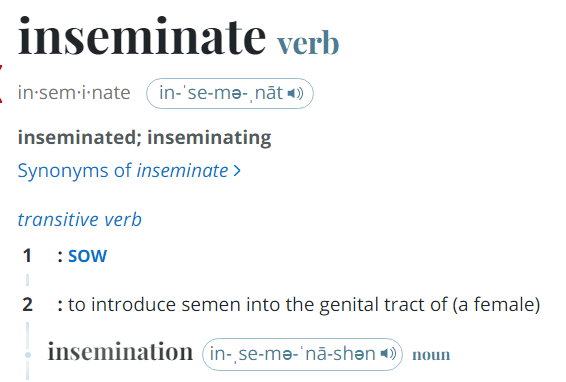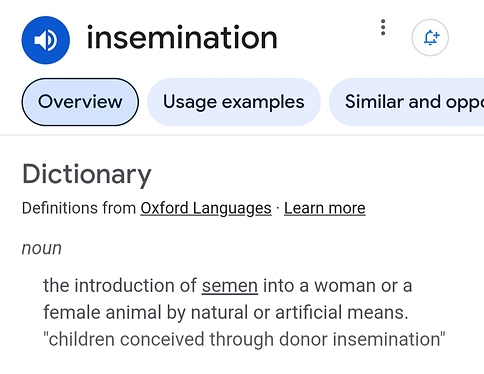I’ve only seen what Sunny-Sam describes twice and that happened with Quarterhorse mares. Another woman in the barn had leased a mare to get a foal and she refused to allow the mare and her new foal to be shipped to a stallion that was about 8 hours away.
This may be TMI, but when a stallion dismounts, he is almost always “dripping”. Sometimes a handler will lean down and grab a dismount sample. (I could swear I once saw someone use a dixie cup.  ) Depending on the farm, and the stallion, the sample may be used to check for motility, etc. or it’s inserted in the mare to reinforce the breeding.
) Depending on the farm, and the stallion, the sample may be used to check for motility, etc. or it’s inserted in the mare to reinforce the breeding.
I’ve always gotten a kick out of the idea of “reinforcing” the cover. You’re inseminating. People might not like that reality, bit it is what it is.
On another note, the Jockey Club has done a brilliant job of keeping the KY breeding farms (in particular) in business. Boarding mares, weanlings and yearlings is a strong source of income for them, and it makes sense to board your mares in the area that they are being bred in.
This also isn’t just the US Jockey Club being dumb and stubborn and antiquated (or whatever else)…the Thoroughbred registries across the world have reciprocity with each other. A US registered horse is considered a “Registered Thoroughbred” in Japan, or Australia, or Turkey. The rules that define a “Registered Thoroughbred” in all registries are the same, or at least very similar, and one of those rules is live cover.
One registry making a unilateral decision to change what they allow in their book risks other registries withdrawing reciprocity. US Thoroughbreds not being considered Registered Thoroughbreds on a worldwide stage would be a disastrous hit to the breed here.
Getting an entire world of registries to change a significant rule is, not unexpectedly, challenging.
It’s easy to look at this as a US only thing, but it’s not. It’s a lot more complicated.
Good point.
I think it’s silly to argue about semantics, but the process is called reinforcing because by actual definition, that’s what it is.
I doubt that anyone in the TB industry has ever given a thought to whether or not they like the word. Because, again, that would be silly.
Putting semen into a mare, by any other means than a stallion’s penis, is inseminating. Clearly, that word is NOT one that the TB world wants associated with their practices, but it is what it is.
Not exactly. “Inseminating” is simply introducing sperm into the reproductive system of a female (or hermaphrodite). It doesn’t indicate how it’s done. So, normal sex is insemination.
What matters then is WHO did the insemination as to whether it was natural, or artificial (by whatever means)
Agree to disagree
There’s a reason “artificial” is added - “artificial insemination” - because it means it’s done by means other than a penis directly depositing semen.
There’s a reason “natural” is added - “natural insemination” - because it means it’s done by the penis directly
It’s not an “agree to disagree” deal

It sounds as though you think you’ve discovered something sneaky and underhanded that needs to be shouted out as a “Gotcha!” moment. Except…everyone is already well aware. The reinforcement of live cover breedings is well known and commonly practiced in the TB industry, and has been for decades. As Janet pointed out above, it’s even mentioned in the JC Rulebook.
Nobody is hiding anything. No one needs to be informed, or lectured about terminology that offends you. In the real world, the TB industry isn’t at all worried about the semantics. No matter what you may think.
I don’t think there’s anything wrong with the JC live cover rule. It’s been done properly for years, by educated breeders who are well aware of how to mitigate any risks.
It’s weird to me that people object to animals breeding the way nature intended, but if all a person has ever known is AI, I suppose live cover could come as a bit of a shock.
Meddling in animal reproduction has resulted in dogs that are unable to reproduce without human intervention, which I think is horrifying.
There’s nothing wrong with horses breeding naturally.
The issue with forced live cover is the relatively large risk of injury to the mare and/or stallion.
In the wild, colts learn a bit of respect from mares while they’re in their born herd, before they’re kicked out into bachelor
If they’re lucky enough to steal another stallion’s mare(s), or take over a stallion’s herd, he still learns respect from the mares
Rarely does any domestic stallion get to learn that as they’re rarely raised in a herd, and this is especially true of TB stallions. Forced LC isn’t the mare’s choice, though to be fair, good breeding operations do their utter best to make sure the mare is as receptive as possible.
Maybe she’s all for it, maybe she’s drugged and/or hobbled or otherwise restrained, maybe someone doesn’t have any idea this mare’s about to lay into the stallion despite appearing ready and willing
I’m not sure, honestly, how many of the TB stallions actually do real live cover, but I guarantee it’s not 100% for the above reasons
Nature isn’t the kindest, most forgiving thing in the world. It’s about survival, nothing more.
Uh what. Covers are often on video. Yes, thoroughbred stallions do indeed jump mares.
What do you think is happening instead???
From your post, I gather that you have little (if any) real life experience with live cover breeding.
The biggest risk is not to the mare, but to the humans.
I’m not saying there is no risk to the mare or stallion, but TB breeding sheds have this down to a science. They know what they are doing and how to keep both mare and stallion safe.
If a mare won’t stand to be covered, she’s not bred. Occasionally they will drug a mare, but that is truly the exception, because see previous statement—if she won’t stand, she’s not going to be bred. On top of only breeding receptive mares, they are decked out in so much protective gear (for both the mare’s protection and the stallion’s) they look like they are going to war.
And yes, it’s “real” live cover. I don’t even know what the implication is with that statement.
I’ve dealt with a lot of breeding and the worst injuries I’ve ever seen are from pasture breeding… because in theory, yeah, colts should learn respect in that situation … but boys. 
…and is easily injured in the process. That is one, among many reasons, why TB horses are not pasture bred.
Never said they don’t. Please read my post again.
I don’t have to have personal experience to have read quite a few personal accounts (as in, they were there, often doing the work) from posters on this forum, stating they collect the stallion and walk over to the mare to inseminate her, because of the very issues I stated.
Are they all lying?
Umm…all of them are doing it. Or they don’t get to produce future TBs. It’s rare but it occasionally happens that a potential stallion has no interest in breeding. (By the way, that interest, as well as the horse’s fertility, will be confirmed with test mares before he ever meets a mare whose owner is paying a stud fee.)
I’ve watched probably more than a hundred live covers. Anyone who has a TB mare booked to a stallion can go and watch the cover if they want. All the newer farms have viewing rooms for that purpose The older farms just put you somewhere safe and tell you to stay out of the way.
Everything is incredibly well organized. Everyone, including the stallion, know exactly what they’re supposed to do, and most covers take less than 10 minutes to accomplish. By the time the mare comes in the shed, she has already met the teaser and indicated that she’s receptive. A mare who balks vehemently when the stallion approaches simply isn’t bred. No farm is going to risk the health and welfare of a valuable stallion for one mare.
The vast majority of TB stallions are very respectful of the mare, the handlers, and the process. They’ve been trained to behave, and they do. With the few bad actors, every effort is made to protect the mare (leather apron over her back and/or neck, bumper beneath her tail, physical support from the handlers, etc). Live cover has been happening for more than a century in TBs and no one who’s involved in the process thinks it’s a big deal.


